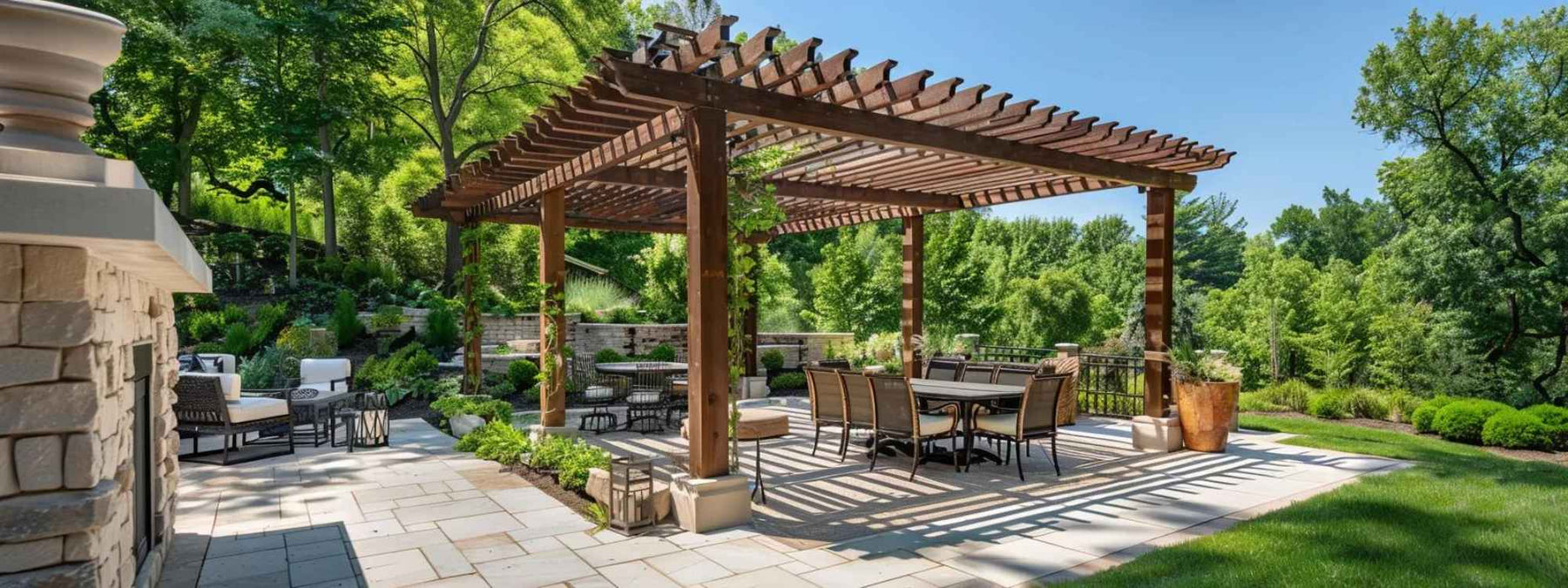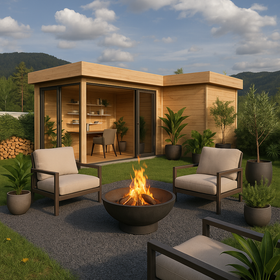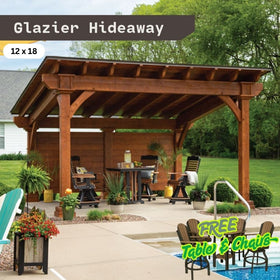512-777-0154

How to Cover a Pergola from Rain?
You finally got the outdoor living setup just right. Table, chairs, string lights, maybe even a grill in the corner.
Then, it happens.
The rain. Out of nowhere.
What was meant to be a quiet coffee or weekend hangout turns into a scramble to rescue cushions, cover food, and question every design choice you’ve ever made.
Pergolas are great for shade, structure, and adding some visual interest to your yard. They’re stylish, low-maintenance, and make your space feel more put together. But when it comes to rain? They’re not exactly built for it.
That part usually gets skipped.
If you’re here, you’ve probably figured that out the hard way. Maybe you’re tired of drying things off after every drizzle. Maybe you’re planning ahead. Either way, covering your pergola from the rain isn’t complicated—if you know your options.
And you’ve got plenty.
Do You Need a Rain Cover?
Not every pergola needs a rain cover. But here’s the thing—some do.
It depends on how you use the space, what’s under it, and how often the sky decides to dump water on your plans.
Quick checklist to help you decide
- Does it rain often where you live? A light drizzle now and then is one thing. Weekly storms are another.
- Do you use your pergola in every season? If it’s more than just a summer thing, some coverage will go a long way.
- Are there outdoor furniture—or a hot tub—under it? Water and cushions don’t mix. Hot tubs don’t appreciate surprise showers.
- Do you use the space to host people? If guests are involved, it helps to have a plan B that doesn’t include everyone running inside.
- Do you still want natural light? Some covers block more light than others. It’s worth thinking about upfront.
When a pergola rain cover makes sense
If you live in a rainy area, a rain cover can save you from dragging porch furniture in and out every other day.
If your pergola is home to a dining table, TV, or anything electric—skip the gamble. Protect it.
Have climbing plants or hanging lights? Water damage can hit those, too.
Even if your setup is simple, covering it helps keep the structure itself in better shape. Less water = less rot, rust, and regret.
Option 1 – Let’s Start Simple: Waterproof Pergola Covers You Can Toss On and Forget
You don’t always need a fancy setup. Sometimes, a quick fix gets the job done—especially if you’re working with a tight budget or just testing things out.
That’s where waterproof tarps and shade cloths come in.
They’re simple, affordable, and easy to install. No drills. No drama. Just basic coverage that keeps the rain out long enough for you to enjoy your coffee without a soggy seat.
Waterproof tarps and shade cloths
This is as straightforward as it gets. You pick a heavy-duty tarp or shade cloth, throw it over your Brookside Timber Frame Zion Resort Pergola, and anchor it down.
That’s it.
If you're renting or not ready to commit to a more permanent cover, this is a great starting point.
Pros:
- Inexpensive
- Easy to put up and take down
- Fits most pergola sizes
- May not look polished
- Can flap or shift in heavy wind
- Needs to be secured well, or it won’t stay put
Grommets, bungees, and hooks—keeping it secure
If you go the tarp route, don’t just toss it up and hope for the best.
Use the grommets (those metal-reinforced holes along the edges) to attach bungees, ropes, or hooks to your pergola frame.
Stretch it tight. Loose fabric is more likely to tear or collapse when it rains. And don’t forget the slope. Even a slight tilt will help water roll off instead of pooling in the center and weighing the whole thing down.
Option 2 – Clear Covers That Let in Light But Block the Rain
If you want to keep the rain out but still let the light in, this one’s worth a look.
Clear roofing panels—usually made from polycarbonate—are a clean, smart solution. They give you shelter without turning your pergola into a cave. And they look more polished than tarps or fabric.
Polycarbonate roofing panels
These are solid, clear panels that attach directly to the top of your Brookside Timber Frame Shadelan Retreat Pergola. They’re usually screwed into the wood or metal frame. Once they’re up, they stay put.
They hold their shape, don’t sag, and stand up well to the elements.
You still get the daylight—just not the downpour. This makes them a great pick if your pergola is a permanent part of your space.
They blend in well and don’t block your view of the sky.
How do they handle rain (and snow)?
With the right slope, water rolls right off. No puddles. No pooling. They’re also strong enough to take on steady rain and even a bit of snow.
It’s a solid upgrade if you want coverage you don’t have to think about after installation.
And no—you don’t need to seal your pergola in like a greenhouse. It still feels open. Just drier.
Option 3 – The Fancy Stuff: Retractable Covers and Motorized Awnings
If you’re after flexibility—and a little flair—this might be one of the best pergola roof cover ideas for you.

Retractable covers and motorized awnings give you control. Shade when you need it. Open sky when you don’t. They cost more than a tarp or plastic panel, sure. But in return, you get something that looks good and works even better.
What makes them worth the money?
Unlike fixed covers, retractable ones let you choose how much light or coverage you want.
Some are motorized. You press a button, and the cover rolls out or folds away. Others use a hand crank, which still gets the job done with a little effort.
Either way, the big draw here is flexibility.
You get rain protection without closing off the space completely.
Design-wise, they’re a step up. These aren’t the plastic blinds of old. Today’s options look sharp—clean lines, neutral fabrics, and frames that blend into your pergola.
Maintenance is real
These covers aren’t totally hands-off. They need to be cleaned now and then to keep them from looking worn.
If you’re in a windy area or expecting a storm, retracting the cover can help prevent damage.
In winter, it’s a good idea to take it down or cover the unit, depending on the design.
It’s not high-maintenance, but it’s not zero either. Plan for a little upkeep, and you’ll get years of smooth, on-demand coverage without surprises.
Option 4 – Nature’s Roof: Climbing Vines and Living Canopies
There’s something nice about sitting under a leafy Outdoor Living Today Western Red Cedar Pergola & Canopy.
It looks good. Smells good. Feels calm. But if you’re hoping it’ll keep you dry, that’s where things get a bit shaky.

Vines and greenery offer some coverage. A light drizzle? You might get away with it.
A proper downpour? Not so much. Water will sneak through. Especially between leaves or when the plant isn’t fully grown.
It’s a great option for shade and aesthetics. Just don’t expect it to double as a roof.
Combine nature with a waterproof layer
Here’s the workaround.
Install a clear, waterproof sheet under the vines. Something like a thin polycarbonate or vinyl layer. Mount it just below the top beams, then let the vines grow above it.
You get the lush, green canopy—but with hidden backup to keep the rain off your shoulders.
Add-Ons That Help: Gutters, Slopes, and Drainage Hacks
A rain cover is a good start to keep your outdoor living space dry and comfortable. But how well it works depends on what’s happening around it.
Water needs somewhere to go. Otherwise, it just finds the nearest low spot—and stays there. These small tweaks can help keep things dry, above and below.
1. Sloping the cover
A flat cover is a rain trap.
Even a slight tilt—around 5 to 10 degrees—makes a big difference. It helps water roll off instead of pooling in the middle.
Less sagging. Less mess.
If you’re installing panels, fabric, or anything solid, angle it just enough to let gravity do the work.
2. Gutter kits for pergolas
You can find simple gutter kits made for pergolas. They’re usually lightweight and easy to install.
Attach them to the edge of the frame to catch runoff. Then direct it away with a downspout.
No more water dripping straight onto your patio furniture.
3. Don’t forget the ground
Even with a good cover, water might still find its way underneath your Brookside Timber Frame Highland Oasis Pergola.
If the area gets muddy, add gravel or a drainage mat. Check that the ground slopes slightly away from the pergola.
It doesn’t take much—just enough to stop puddles from forming right where you want to sit.
Things to Avoid So You Don’t Regret Your Cover Later
Some mistakes are easy to make. But they can turn a simple rain cover into a source of constant frustration.
Here’s what to skip—so you don’t end up redoing the whole thing in six months.
- Flat, non-sloped covers: Rain needs somewhere to go. If your cover is completely flat, expect puddles. And sagging. And possibly a waterfall you didn’t ask for.
- Cheap plastic with no UV protection: It might look fine on day one. But give it a few sunny afternoons and it’ll start to crack. Look for materials rated for outdoor use. Bonus points if they block UV.
- Screwing directly into fabric: Don’t do it. The fabric will tear over time. Use grommets, washers, or bungee cords. They spread the pressure and keep things secure.
- Forgetting about mildew: If you’re using canvas or fabric, it needs airflow. Trapped moisture turns into mildew fast. Leave space for air to move—or deal with the cleanup later.
You’ve Got Options—Just Pick the One That Fits Your Lifestyle
Covering a Brookside Timber Frame Timber Resort Pergola from rain isn’t about finding the perfect solution. It’s about choosing what fits how you use your space.
Maybe you want something quick and temporary, like a tarp or waterproof shade cloth. Or perhaps you prefer a clear, semi-permanent solution that keeps your space bright and inviting.
Then again, you might love the idea of something fancy and retractable that adapts to the weather and your mood.
The good news is that even the simplest setup can be a game-changer. Your goal isn’t to build something flawless—it’s about making your outdoor space enjoyable, rain or shine.
Pick what makes sense for you. Start small if you need to. Upgrade later.
If you found this useful, we’ve got plenty more practical guides on making your outdoor living better. Feel free to check them out.








